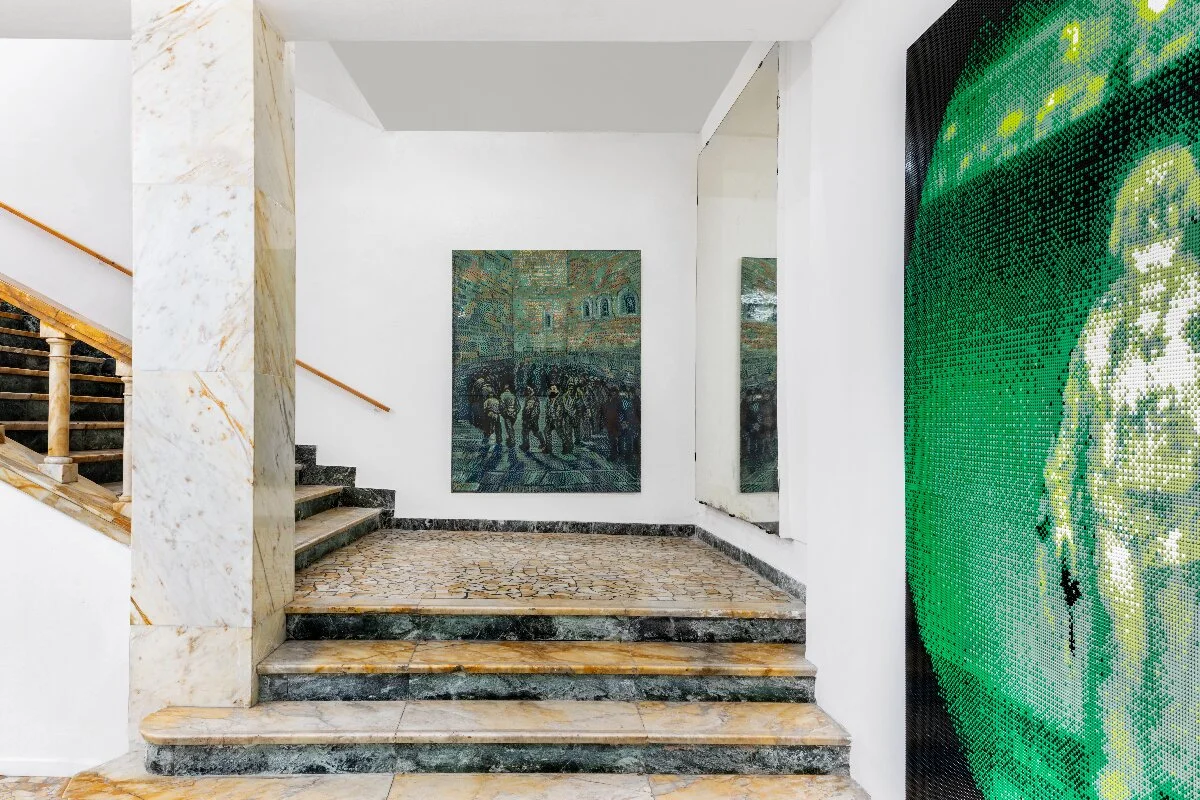Working with natural materials – «What would the retro-futuristic extension of the Tudor era be?». Steve Webb goes back to the fork of the road where we went wrong in the construction industry
Sustainability is key, but what is next? – Steve Webb
When sustainability was first applied to the construction industry, «it was about implants like air conditioning or heating» explains Steve Webb, co-founder of London-based practice Webb Yates Engineers. The symbol of early-days sustainability was «a very efficient air conditioning system in a massive concrete and steel building».
Looking back now, it seems ridiculous: «you have a zillion tons of carbon in the frame, and you’re playing with the air conditioning, » as Webb puts it. In twenty years, the industry has developed and learnt, but there is still plenty of greenwashing. For Webb Yates, being a sustainable practice was not a conscious choice at first: «it is something we were interested in and we seem to have gotten a reputation for, but It wasn’t an intentional agenda».
Today, everyone in the business is talking about sustainability, and «we know what people were not seeing and not recognizing in 2010 or 1990 when global warming was first publicized». According to Webb this is not enough any longer. «The question is: what are we not seeing and recognizing now?». It is about work, the way we structure taxes, and about social justice.
Building as a positive force
«Everything is connected», and building is a huge industry. Buildings «are our biggest material endeavors and have a huge impact socially, economically, environmentally». As much as today it is one of the industries with highest registered emissions, construction could be a positive force, driving for change. It must be looked at with a holistic and pragmatic approach: «the economics of building can be really powerful for improving employment, quality of life for both employees and people who live in buildings».
Steve Webb on the value of materials
At Webb Yates, sustainability means sticking to the substance of the built environment: starting from materials. With steel and concrete, the emissions are almost palpable. They are in the process: «you can see all the fire in the process, all the factories and the smoke». Webb is interested in «in switching out of steel and concrete whenever we can and unless they are absolutely necessary, and using either less of it, or timber and stone instead». It is a personal goal and passion on top of a challenge to save the planet: «it is intellectually interesting to try and make bigger and more complex things with timber and stone – the fact that it’s a moral enterprise is nice as well».
It started with a staircase: Steve Webb and stone
The first encounter with stone was in Spain. Webb was working for Calatrava in Valentia: «we were working on a flat and we had to build a staircase, attached to a thin, terracotta partition wall». Having someone make it was expensive, so Webb decided to try and do it himself. It was a plywood staircase, with a principle copied from a stone staircase, with one thread on top of the other, a particular system that allows the staircase to stick out of a wall. He made the design with timber. After some time, having co-founded Webb Yates, the stairs came back. This time, he worked with stone.
The structural potential of stone
A stone mill asked them if they could do some calculations: «normally the staircases are fixed to walls, but he wanted the staircase to span freely so we started experimenting by putting cables inside the stone». Reinforcing stone with cables. Out of curiosity, they started looking at the sustainability of stone. The results were impressive. Stone is incredibly strong: 200 Newton; 150 Newton in compression; 10 Newton in tension. The best feature is that the stone is there: «you just take it out of the ground and use it: no factories, no smoke, no fire, none of that».
Steel, timber and stone
«Steel has four times as much embodied carbon per square meter as timber, » says Webb: there is a huge difference in making a structure out of wood or steel or concrete. Stone has even lower embodied carbon than the timber, because it is stronger: you need less. If you get a piece of stone out of the ground, its strength is about 100N, whereas the strength of the timber is just 7.5N.
«We are working out this new unit: meter cubes per newton per year, so how much, how strong, how long. In 25 years, you get one cubic meter with a tree, whereas if you dig the ground underneath you get five cubic meters of 150N each in about three months». The idea that timber is carbon negative can also be challenged: it is true that trees grow back, «but what is key for us is the carbon now, not the carbon in twenty years’ time». According to Webb, the best combination is using timber and stone. Although CLT and GLT can be a good way to go, for Webb the goal is to manage to use wood in its natural form, like he does with stone.
Concrete is counter-intuitive
Concrete must go through a number of processes to be made. You elaborate something that is available, by producing emissions. It is not intuitive: «to make cement you take limestone, you crush it, you burn it, you smash it, you then put it together and on a building site». Webb advocates for using the original natural materials, saving an incredible amount of CO2.
The natural materials also have more beneficial features: «you end up with a piece of concrete which has about twenty percent of the strength of the original stone». Stone is much stiffer and stronger and has fewer long-term effects: «when you compress concrete it slowly shrinks over time, and stone does not do that».
Steve Webb explains: historical reasons for concrete
Saying concrete is counter-intuitive is simplistic. There are reasons why it was invented – mainly historical, as Webb explains. At the time of the invention of concrete, they were on the upswing of the fossil fuel era: «they thought we’d have limitless energy and that would not be a constraint». The curve of the availability of energy seemed endless. It was fine to elaborate materials even if this meant high energy consumption and emission. People were not aware of the issue yet. The situation has changed: «now we are on the downswing and must recognize those decisions were wrong and nobody today would invent cement».
Evolution in the use of materials: back and forward in time
What works at a point in time does not have to work forever. For instance, the first bricks were made in Damascus, because they had rivers and mud; it was an obvious reason why they started making them. «In China they then started to burn the bricks for the first time: if you burn the bricks you need far less mud, so you have to dig less».
Burning coal rather than using human labor: «rather than working all day and using your energy you would extract some of the energy needed to build». Before then, it was different: «in London in particular, everything was made with stone and timber, because at the time they had no other energy». Then the great fire of London happened, and they started bringing coal to London to make bricks. «But today», says Webbs. «It is an intellectual aberration to make bricks: they have a massive embodied carbon».
Webb Yates going back, to go forward
Webb aims at going back before the coal era began: «you go back to go forward: going back to that fork in the road where you went wrong, and then you go forward again with what you know now». This is not about nostalgia. His main interest is imagining how buildings would look like today, if we did not start creating reckless emissions to build them.
If we respected the natural form of materials. «What I’m interested in is, if fossil fuel hadn’t happened, what would the retro-futuristic extension of the Tudor era be?». He goes even further. It is both a question of aesthetics and substance: «buildings should be a true reflection of the circumstances [they were built in] and the circumstance is we have a climatic and social problems, if we build with stone and timber we can create employment and we can solve the carbon problem all at the same time».
The role of income tax
Architecture often seems like an abstract discipline. It has both very practical implications and concrete dynamics: the laws of economy have an impact on how we build, how we think of buildings, how we design them and how sustainable we manage to be. This has a lot to do with taxes and how jobs are regulated.
«If you tax labor, you make it more expensive. If at the same time you don’t tax materials, the solution is going to be using more materials and less labor». When labor is more expensive, the time it takes to design is more expensive, «so you end up using big fat lumps of concrete and steel and using much more material to mitigate against the costs of labor». At the expenses of both the environment and social justice.
Building better, with less
The opposite is also true: «When environments have very cheap labor and material is expensive the result is beautiful, lightweight structures that are less extractive, more designed, more intellectual, with less material». According to Webb, it follows that «income taxes create unemployment». There is then a huge disadvantage to employ people and an incentive to use more material and automate in the construction industry. At the time it wasn’t a strategic decision, Webb explains, but it really ended up favoring the capital, things and machinery over people. This model is anti-humanistic because you employ less people because you can’t afford to pay them. You diminish their work and make them less intellectual».
15 Clerkenwell Close by Webb Yates
15 Clerkenwell Close is a mixed-use six storey building with a stone façade Webb Yates worked on. At first, they thought it would be the perfect combination between stone and timber. They wanted to make the floors in timber but couldn’t because of the spans and limitations: «we could not make the building any taller which meant we could not make the floors deep enough to be timber».
The concrete frame was built without any temporary props and then the stone frame was lifted in and connected. In the façade, made entirely of stone, that supports the whole building, here are three different finishes – a drilled finish, a split finish and a cut finish. «When you extract the stone from the quarry you end up with three finishes; the architect spent as little as possible on that and just accepted the finishes as they came – so this is the most economical way of building it, it’s not a stylistic adaptation».
A new architectural language for stone
In the XXI century, engineer and architect Owen Williams instilled the idea that concrete needed to have its own language. He gave it one, building differently than anyone before him and making the nature of concrete visible. Today, Webb says, stone is a material waiting for its own language: «the problem is that we design with stone as though it was just another form of concrete». It should be given an aesthetic in its own right.
Webb Yates
Webb Yates Engineers is a multidisciplinary engineering practice comprising structural, civil, mechanical, electrical, and public health engineers.




















